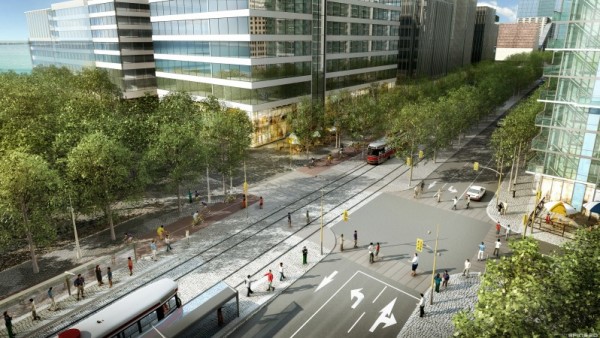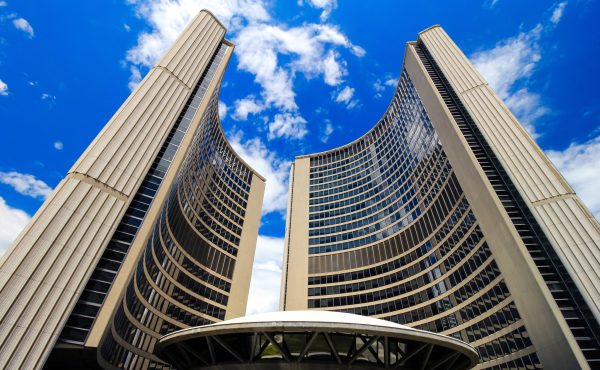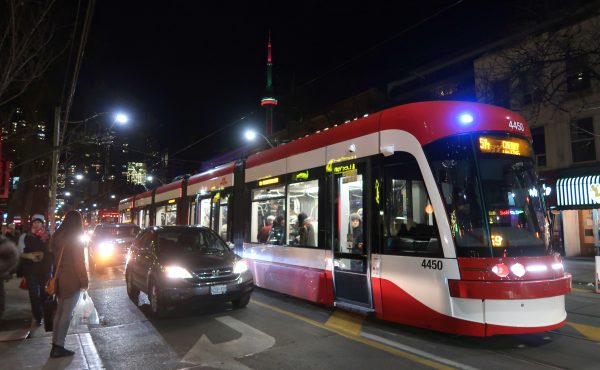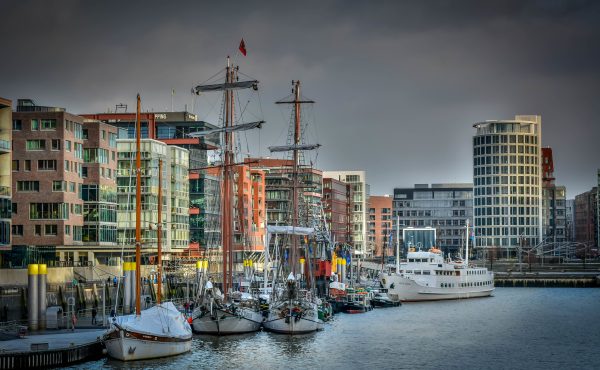When Brampton council voted last week to kill a rapid transit line that would not have cost the city an, um, red cent, one thought sprang immediately to my mind:
Hey Metrolinx, give us the dough! Really!
Toronto could invest Brampton’s unwanted $300-400 million portion of the $1.6 billion Hurontario-Main LRT on a new light rail line that is defensible from a transit and land-use planning standpoint, welcomed by current and future area residents, and will be extremely well-used from the day it opens.
I’m talking, of course, about the proposed Queen’s Quay East LRT — a project that everyone agrees is necessary for the continued development of the waterfront and the Port Lands, and yet remains unfunded even while we bend ourselves into contortions worthy of Cirque du Soliel in order to spend lavish amounts on far more dubious schemes.
The utter perversity of the current picture is remarkable and depressing.
We have one municipality, Brampton, which has now twice refused a game-changing rapid transit project because some of its councillors are afraid of development in the downtown!
We have another, Toronto, which wants to spend the next dozen or so years, plus untold billions, on a three-stop subway that will run through low-density Scarborough residential neighbourhoods with almost no re-development potential.
And we apparently have a behind-the-scenes tug of war going on between Mayor John Tory and the Metrolinx planners over what, exactly, Smart Track will become, if not Regional Express Rail. It’s an extraordinarily high stakes dispute over a rapid transit proposal that no one, including provincial and city analysts, quite understands, but will nonetheless cost gazillions of dollars, a good portion of which remain uncommitted (i.e., $2.6 billion of federal funding that Tory promised).
So much money these days seems to be chasing after pie-in-the-sky schemes, and yet the one place in the region where there’s a slam-dunk opportunity to align land use planning, development and transit infrastructure continues to go begging.
Bizarre.
Quite apart from the transit policy considerations, there’s the whole matter of the self-immolating governance context that has allowed a single Brampton councilor to roll the entire region, Queen’s Park and its delivery agent, Metrolinx.
The Metrolinx route has been subject to a significant amount of technical analysis, and the various alternative schemes, proposed last year by Brampton councillors, were roundly dismissed in an extensive review by SNC Lavalin. The EA has been completed and vetted by the province’s environment minister. The project has been approved by the Metrolinx board, and funded by cabinet. The Liberals under Kathleen Wynne ran on a mandate to invest $15 billion in transit in Greater Toronto. And if all that wasn’t enough, all but one of Brampton’s MPPs are Liberals.
Anyone who suggests the Hurontario-Main LRT hasn’t been exhaustively scrutinized, technically and politically, is living in a fantasy world.
And yet, Wynne’s Liberals do nothing to rectify a regional governance vacuum that tolerates, and in fact encourages, the endless cycle of re-litigation that has paralyzed Toronto transit planning and now seems to be infecting the 905 suburbs. It’s as if the provincial government wants to fail.
I think one can legitimately ask how much democracy is too much democracy in situations like these. I understand that the provincial Liberals have no appetite for the sort of regional governance reforms proposed a generation ago by Anne Golden. But why can’t cabinet approve regulations that lay out a less open-ended approvals protocol for large regional projects?
Surely the government could pass legislation or an order-in-council that clearly articulates the required vetting stages, and also establishes a specific end-point – an explicit take-it-or-leave-it moment that signals all the little pooh-bahs in local councils that they can’t filibuster indefinitely.
Municipal councils with concerns can engage at the level of land-use planning choices along duly scrutinized corridors, subject to the constraints already imposed on them in the Planning Act, the provincial planning statement and the Places to Grow legislation. But if the province’s money is in play, shouldn’t the province have the final say on the high-level decisions (e.g., route recommendations from its delivery agent, Metrolinx)? Seems like a no-brainer to me.
None of these changes would require the creation of costly new bureaucracies or mega-councils. Yes, there will be howls of self-righteous indignation from those self-important protectors of local god-knows-what. But to govern is to chose, as the old saying goes, and if we are to ever get to yes, the province needs to establish a decision-making framework with an end point that does not confer the final say on politicians with the most parochial concerns.
Alas, we don’t have that governance system, as the debacle in Brampton attests. So in the spirit of constructive reform, I propose this reasonable alternative: if a council says no twice, it should lose the money – period and end of sentence.
Spend those valuable resources where they’re wanted and needed, I say.
And in Greater Toronto circa 2015, that place is Queen’s Quay East.






7 comments
once again I suspect Brampton Council has its own agenda which is to develop a new “Four Corners” at Main and Steeles. This is where future development will take place in addition to the major development there over the past few years and now the location of the LRT terminal.
Council seems reluctant to discuss this as it also puts the last nail in the coffin of the “historic” four corners. Why would anyone invest there now?
As per Lorinc… “But why can’t cabinet approve regulations that lay out a less open-ended approvals protocol for large regional projects?” Or why can’t Metrolinx just be the final arbiter? Is that not why the province created a regional transit coordinating body to stop the all the parochialism?
And yes, the money should be moved to either Toronto’s Queen’s Quay East streetcar and/or Hamilton’s B-line LRT (or split the difference). Super worthy projects in parts of the GTHA that actually understand transit-oriented development.
The problem with “spend Metrolinx Brampton money on QQE” may be accounting based. Anything south of Eglinton remains owned by the City/TTC. Eglinton and Finch are Metrolinx/Provincial assets. QQE is too intertwined with TTC to be anything but a Metrolinx grant.
That said, there are other Metrolinx driven projects which could use the cash. If John Tory could get it through his skull that his Eglinton West smart track is insane, $400m would get some early parts of Crosstown2 done. Alternatively, it could fund expediting Finch West phase 2. Both of these would remove many buses from TTC’s capital needs in the 2025+ timeframe.
Right on John. Brampton is totally un-worthy of receiving money for transit. Let’s use their money for the Queen’s Quay East LRT. I’m all for it. Shame on them.
There’s something to be said about having a dictatorship. At least they get things done. “When is democracy too much democracy?” If Metrolinx had more “balls”, we wouldn’t be in this transit mess.. Point well taken about the Liberal government almost seemingly wanting to “fail”. The more endless debates, reports, studies, bickering within municipalities, etc. will all prolong the government to actually having to spend money on transit!!!
Just as the Province is deferring to Brampton council, it also listens to Toronto’s Council, currently led by Tory. As under Ford, Tory has let the Province & Feds know that funding should be steered to suburban subways (currently Scarborough), whatever SmartTrack turns out to be and the Gardiner, rather than the DRL or Waterfront LRT, for example.
On the other hand, Tory says he’ll do whatever is necessary to help Great Gulf’s Unilever proposal. Their top priorities are the Gardiner hybrid, Unilever GO station and flood proofing, but they also say they need an LRT extended under the rails to their site.
Meanwhile there’s an 8km gap between the Eglinton Crosstown and the Mississauga Transitway that needs to be filled, stop with the Smart Track and extend the Crosstown to Winston Churchill Blvd by electrifying the Transitway as well.
Metrolinx should use the money to fund Eglinton Connects, the as-yet unfunded $150+ million streetscape plan that goes with the Eglinton Crosstown LRT. It is completely absurd to have Metrolinx rebuild 100-200 metres in front of each station with a new streetscape design, while leaving the rest of the streetscape untouched (and worn out after 10 years of intensive construction).